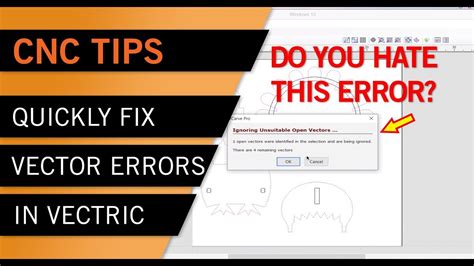VCarve: Avoid These Common Vector Copy Mistakes
VCarve is a powerful tool for creating intricate designs for CNC routing and other machining processes. However, even experienced users can fall prey to common vector copy mistakes that lead to frustrating errors and wasted material. This article will cover frequent pitfalls and provide practical solutions to help you refine your VCarve workflow and achieve precise, clean cuts every time. We'll delve into several crucial areas to ensure your designs translate seamlessly from screen to finished product.
Understanding Vector Copying in VCarve
Before we tackle specific mistakes, let's establish a baseline understanding. Vector copying in VCarve involves duplicating vector shapes, either within the same project or across different files. This process is crucial for creating repetitive elements, symmetrical designs, and efficient use of material. However, improper techniques can lead to several problems.
1. Incorrect Copying Methods: The Root of Many Errors
Many issues stem from using inappropriate copying methods. Simply using the standard copy-paste (Ctrl+C, Ctrl+V) functionality without understanding the implications can result in unexpected behavior. This method often copies the original vector data, meaning subsequent edits to the original affect all copies. This is undesirable in most cases. Instead, consider using VCarve's built-in "Duplicate" command or the more advanced "Copy & Paste Special" options for greater control.
How to Avoid This:
- Utilize the "Duplicate" command: This creates a completely independent copy of your vector. Changes to the original won't affect the duplicate.
- Understand "Copy & Paste Special": This offers options to copy only specific attributes, preventing unintended changes and scaling issues.
2. Scale and Position Issues: Maintaining Accuracy
Scaling and positioning copied vectors is critical. Incorrect scaling can distort your design, while misaligned copies ruin symmetry. Ensure your scaling is consistent and accurate using the tools provided within VCarve to avoid these issues.
How to Avoid This:
- Use the constrain aspect ratio feature: When scaling, prevent distortion by keeping proportions consistent.
- Employ VCarve's snapping features: These assist in precise placement, aligning copied vectors accurately.
- Use the "Move" tool with precision: Rely on numerical input for exact X and Y coordinate adjustments.
3. Overlapping Vectors: A Recipe for Chaos
Overlapping vectors can lead to confusing toolpaths and undesired cuts. VCarve might interpret overlapping lines differently depending on the toolpath strategy, leading to unexpected results. Review your copied vectors thoroughly before processing.
How to Avoid This:
- Employ Boolean operations: Use the "Union," "Difference," and "Intersection" tools to combine or subtract vectors as needed.
- Visually inspect your work: Zoom in and carefully examine your design for overlapping or unintended intersections.
4. Incorrect Layer Management: Keeping it Organized
Failing to manage layers effectively when copying vectors can create a disorganized and unmanageable project. Keeping track of which vectors belong to what part of your design becomes nearly impossible, leading to errors and frustration.
How to Avoid This:
- Create separate layers for copied elements: This provides organization and allows for easier selection and editing.
- Use descriptive layer names: Make your layers easily understandable by using informative names.
5. Forgetting to Check Toolpaths: The Final Safety Net
Even with perfectly copied vectors, incorrect toolpaths can ruin your work. Always review your toolpaths before starting the CNC machine to ensure everything is precisely as intended.
How to Avoid This:
- Simulate your toolpaths: Use VCarve's simulation feature to preview your cuts. This is a crucial step before committing to machining.
- Carefully check clearances and speeds: Ensure your settings are appropriate for the material and tool used.
By following these tips and adopting a methodical approach, you can significantly reduce the likelihood of encountering vector copy errors in VCarve. Remember, precision and planning are key to achieving high-quality results in CNC machining. Happy carving!

